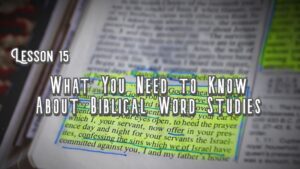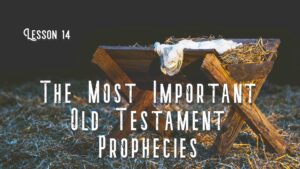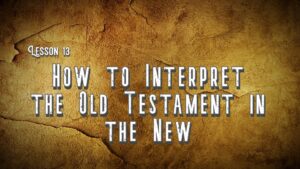Studying the Bible is more than just reading one verse at a time, coming up with a few anecdotal quips, and moving on to the next verse. Hopefully the previous lesson made this fact clear. In this lesson we learn how studying singular verses in isolation can lead to misunderstanding scripture. This goes beyond studying the words of scripture themselves and into observing how those words are arranged intentionally.
Form shapes content.
Leland Ryken quips, “In a literary text it is impossible to separate what is said (content) from how it is said (form),” (Comfort 124). Identifying how the message is intentionally formed: this is what is meant by studying the Bible as literature. Notice the difference between Acts and Psalms. You should notice a remarkable difference in the form of writing. Acts tells a progressive story with one scene building on the next. When reading Acts 3:1-10, the reader must pay attention to what comes before and after this scene in order to understand why the healing of the lame man is relevant. The healing is sandwiched by sermons from Peter about the spiritual restoration of Israel. No doubt, the story of the lame man’s strength being restored has some illustrative import to Peter’s sermons. The amazing power of God displayed in healing the lame man is the same power at play in restoring lost souls through the gospel. As opposed to this beautiful rhythm found in Acts 2-3, Psalms is a series of stand alone poems in which Psalm 51 is not necessarily connected with the psalm either before or after. There may be exceptions, but it would seem that intended connections from one psalm to the next is infrequent. This example illustrates why identifying the type of biblical literature is important: history (Acts) versus poetry (Psalms).
The are many different types of literature used by the Bible writers: historical narrative (the gospels), poetry (Job), apocalypse (Ezekiel), prophecy (Jeremiah), argumentative discourse (1 Corinthians), and legal documentary (Ezra 1:2-5). Within these categories are more subcategories which make things a little difficult. Narrative is the most common form of literature in the Bible. With that being said, examine how the teachers at your church approach the scriptures during a midweek study.
The Popular Approach
This approach to studying the Bible requires no specific rules of interpretation. Consequently, this approach is becomes very high risk for misinterpretation and false teaching. Let’s see how the gospels are interpreted using this approach.
The gospels are nothing more than one disjointed snapshot from the life of Jesus, one after another, together giving various evidences for Jesus. More importantly, they were meant to provide hundreds of sermon illustrations. I may not have a clue what a passage means, but it sure provides a good illustration!
You may notice this approach employed by the teacher who opens up reading a Bible passage and proceeds to give a sermon on a totally unrelated subject. This is the way many people approach studying the gospels whether they will admit it or not. This is not to assume that the average teacher approaches the scripture with dishonesty. Many have simply never had anyone show them a better way. A better way starts with realizing the Bible writers used great care in crafting their inspired accounts, not only the words themselves but also the arrangement of those words. Failing to notice how Matthew and Luke meticulously arranged their information (literary style) determines whether one catches the message or misses the mark at times.
Consider the story of Lazarus. How many times have you heard the story of Jesus raising Lazarus? This story in John 11 has been preached to death (pun intended) in comparison to other gospel narratives. However, rarely ever does a preacher actually explain why John chose this story out of all the other things that Jesus did (John 21:25). Is the raising of Lazarus just a story to teach compassion as a character trait that needs to be lived out? Is it nothing more than one more miracle attesting to Jesus’ deity? It seems more logical that Jesus proving to have power over death and the grave as He approaches Jerusalem for the final time makes the arrangement of the Lazarus story in John’s gospel helpful to its interpretation. Again, form shapes content.
The Literary Approach
This approach realizes that John’s gospel is a historical narrative with a plot line introduced in Chapter 1 and progressively developed until its climax in Chapter 19. Immediately preceding the raising of Lazarus, Jesus teaches He is the good shepherd prophesied about in Ezekiel 34 and makes an announcement, “The good shepherd gives His life for the sheep,” (10:11) and, “I lay down My life that I may take it again,” (10:17). The good shepherd speech sets up the scene for Jesus to raise Lazarus from the dead, at which point He says, “I am the resurrection and the life…” (11:25). It is no coincidence that this is the last miracle Jesus performs before being crucified and resurrecting. Neither is it a coincidence that in the very next chapter, Jesus is anointed in preparation of His own death (12:7-8).
Thus, while someone might teach the importance of compassion from John 11, or Jesus’ deity being proven through yet another miracle, this misses the central point of Jesus raising Lazarus from the dead. This historical narrative is given at a turning point in John’s gospel to preview Jesus’ own death, followed by resurrection. Historical narratives typically have progressive scenes that build on one another until reaching a climax, and John’s gospel holds true to that pattern.
To summarize, identify the type of literature employed by the Bible writer. The type of literature being written will influence its shape. Remember, the individual words of scripture are important, but how those words are arranged will help determine the single meaning of a verse or set of verses. With all that being said, make sure to examine a verse’s immediate surroundings before making free application.
Homework Questions
1. What does it mean to study the Bible as literature?
2. Which type of literature is most commonly found in the Bible?
- narrative
- poetry
- argumentative discourse
- prophecy
3. Read Daniel 7 and identify what type of literature would best describe this writing. Choose one of the answers from the list given in the last question.
4. Read Psalm 1 and identify what type of literature would best describe this writing. Choose one of the answers from the list above.
Helpful Resources
The Origin of the Bible by Philip Comfort
How to Read and Understand the Biblical Prophets by Peter J. Gentry
The Acts of the Risen Lord Jesus by Alan J. Thompson



